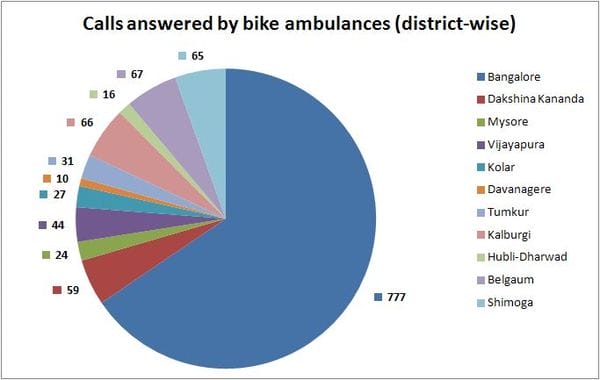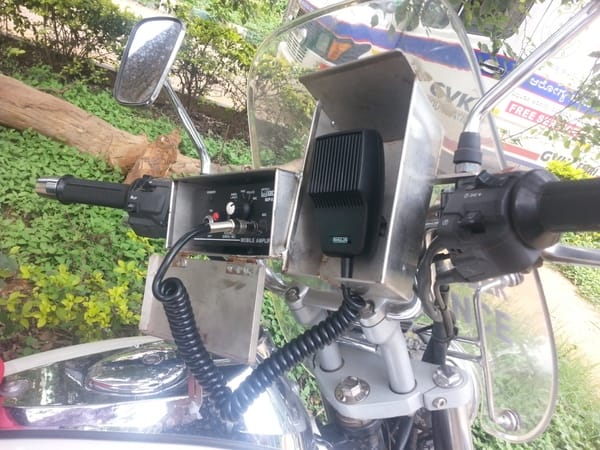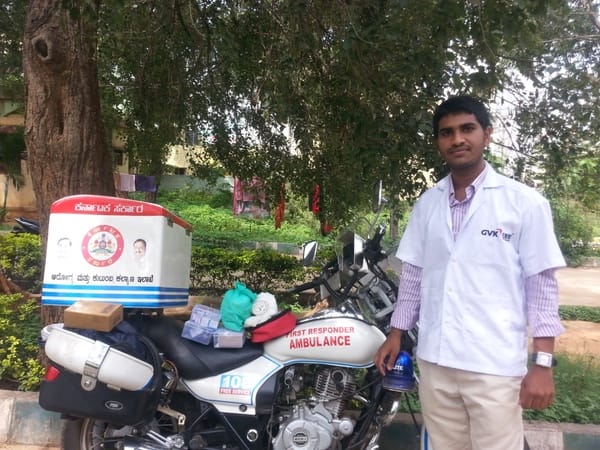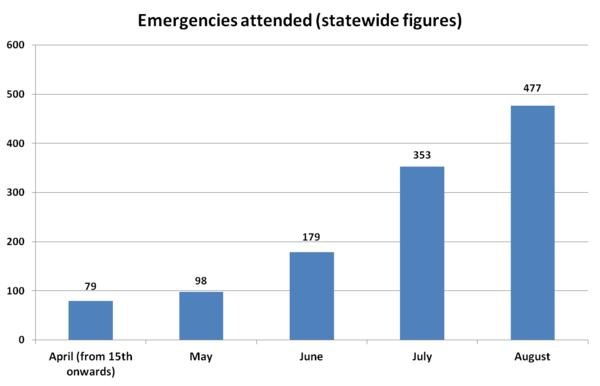A two-wheeler collides with another vehicle, spilling its rider onto the pavement. An onlooker reacts immediately, pulling out his or her cellphone to dial the emergency number, 108.
What happens next is a series of snap-decisions and hasty phone calls to ensure a medical professional arrives on site as quickly as possible. Depending on the location, the Emergency Disaster Management Unit call centre, being run by GVK-EMRI, sends an emergency vehicle.
Since mid-April, a new type of vehicle has been added: the bike ambulance. For these two-wheelers, weaving through Bengaluru’s terrible traffic, is much quicker than their four-wheeled counterparts.

If the victim in our hypothetical accident has not suffered a severe injury, the call centre may send a bike ambulance with a trained paramedic and a plethora of tools onboard, including a nebuliser, a glucometer, and a laryngoscope. These bike ambulances are equipped to treat most minor wounds, take vitals, including pulse and blood pressure, and even provide oxygen thanks to a hefty toolbox attached to the back of the bike.
How does a bike ambulance work?
“We reach them first. Then, depending on the emergency, we give first aid,” says Purushotham K, a bike ambulance driver. “If they are only slightly injured, then the four-wheeler ambulance is not necessary, there is no need to hospitalise them.”
‘Slight’ injuries include scrapes, small cuts and bruises. However, if the person is not breathing, is deeply cut or has a serious injury, we call for a four-wheeler, and call a doctor to receive medical advice on how best to treat the patient, he says. “The doctor will guide us on what has to be done,” he adds, “So we act according to the suggestions of the doctor.”
According to Purushotham, the average response time is about five to ten minutes, varying depending on the area and traffic. As of August 25th, bike ambulances have responded to over 700 calls in Bengaluru alone; that’s over half of total calls responded to by bikes in Karnataka. Of those, about 95% were ‘minor trauma/accident’ cases, and in about 40% of cases, a four-wheeler ambulance was called to assist.

Number of emergencies tended to by bike ambulances (district-wise)
The 18 bike ambulances in Bengaluru are positioned at unique locations and respond to the call centre in Basaveshwara Nagar that takes all emergency calls for the state. “From there, depending on the emergency, they will summon an ambulance,” Purushotham said.
Bike ambulances are not dispatched for emergencies that require immediate transportation of the patient. Purushotham elaborates: “We don’t send a bike ambulance for cardiac cases, because the bike can only seat one person.”
The tools, the vehicle and the training
The cost of the bike, a Bajaj Avenger 220-DTSI, and the 40 medical tools it carries, amounts to about 1.5 lakhs a piece. Bike kits are restocked once a month, more frequently if necessary, to replenish depleted supplies and get rid of those nearing their expiration dates.

The bikes are equipped with a loudspeaker to help clear traffic when drivers are responding to a call. Pic: Holly Thorpe
The bikes also come equipped with a siren and a handheld loudspeaker to help clear traffic. Purushotham and another driver, Manjunatha K, agree that people are almost always responsive to the noise, and clear the way to let them through.

Manjunath, driver at the Singasandra location, stands next to his bike, wearing the GVK EMRI shirt he will wear when responding to a call. A few small medical kits taken from the larger tool-kit are placed on the seat. Pic: Holly Thorpe
The paramedics are trained for 45 days with an emphasis on trauma life support. They typically work four, 12-hour shifts at a time, with one day of rest in between. “[In the morning] we come and check the equipment and the vehicle everyday and get ready,” Purushotham says. Drivers respond to, on average, one call a day. Purushotham says that all 18 drivers respond to an estimated total of 10 to 12 calls per day. “[Drivers] feel happy, and at the end of the day, we feel we are doing a good service for the people,” he says, “At the end of the day, we’re definitely proud.”
And how has Bengaluru responded to it’s new bike paramedics? “Usually, when people see us for the first time, they are surprised,” he says, “But they’re happy to see us. The reaction from the public has been positive.”
Cases attended by bike ambulances
The pilot program consists of 29 bikes in Karnataka, with 18 stationed across Bengaluru, in locations including Sarjapur, Singasandra and Malleshwaram. The service has been implemented with the help of GVK EMRI, the same organisation that manages the ‘108’ ambulance service. Launched in April by the Government of Karnataka, the bike ambulance program aims to allow first responders to reach the spot of the emergency as quickly as possible.

Statewide figures for number of emergencies attended by bike ambulances
From April 15th until August 25th, the total number of emergencies attended by bike ambulances in the entire state was 1,186. Of these, 19 were ‘critical’ or fatal cases, 1,000 were ‘minor trauma/accident’ cases, and just under 200 were for other emergencies including accidental poisoning, unconsciousness, and violence or assault. Just under half of the cases in the state (533), were then referred to 4-wheeler ambulances, after the bike ambulance Emergency Medical Technicians (EMTs) arrived.
How are the vacancies filled?
The role of those manning a bike ambulance is a rather unique position to fill, requiring more than just paramedic experience. In the beginning, this proved problematic, said Health Commissioner PS Vastrad in an email. “It is a bit more challenging to find paramedics with valid driving licenses and experience of driving vehicles.”
Purushotham had worked with GVK previously, and so was notified when this position became available. For Manjunatha, the driver at the Singasandra location, this is his first job after graduating.
Because this is still a pilot program, Vastrad said the government is not yet considering adding more bike ambulances.
(With inputs from Rahul Ravi)
This is awesome.. in a country like India where we have large number of bike users and two wheelers are more prone to accidents on roads. Be it minor or major the bike ambulances will be the key to help accident victims as first aid and depending upon the seriousness an ambulance can be called. Very good move and idea by GVK EMRI. This concept must spread to every Indian city.